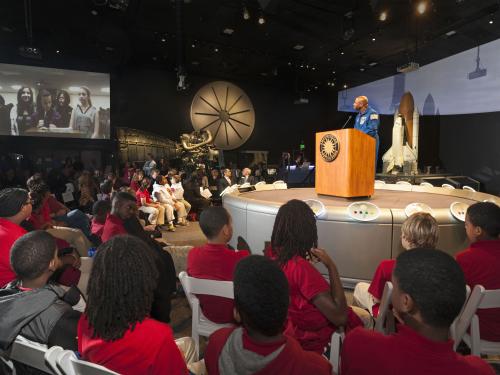
Stories of daring, stories of technological feats, stories of prevailing against the odds ... these are the stories we tell at the National Air and Space Museum. Dive in to the stories below to discover, learn, and be inspired.
Showing 91 - 100 of 111

April 26, 2013
How do you bring together two orbiting astronauts and more than 12,000 students scattered around the U.S. and Canada? It’s not rocket science, but it's close. First you have to find some very dedicated partners with a common purpose, like the Smithsonian National Air and Space Museum, the National Aeronautics and Space Administration, the U.S. Department of Education, and the National Center for Earth and Space Science Education. Second you have to ensure an audience; which isn’t very difficult because who wouldn’t jump at the chance to talk to astronauts while in space? Third, and most challenging, you have to put together the technology capable of linking 24 sites scattered around North America and Hawaii with something moving at 28,163 kph (17,500 mph) 354 km (220 miles) above the Earth’s surface.

April 23, 2013
My first word was JET, since we lived near an Air Force base and experienced sonic booms on a regular basis. My fascination with the heavens took off from there. Growing up, my family went camping and backpacking a lot, and one of my clearest memories of that time is looking up at a dark, dark sky and pointing out satellites to each other, those little moving points of light that are sometimes so faint I could only see them in my peripheral vision.

February 15, 2013
A particularly bright fireball was observed earlier today over a wide area in Russia. Of even greater significance was the very strong sonic boom associated with the passage of the meteor through Earth’s atmosphere.

December 17, 2012
This September, Larry Crumpler, a research colleague at the New Mexico Museum of Natural History and Science, and I were able to fly in the back seats of two weight-shifting ultralight aircraft during a two-hour flight over the McCartys lava flow in central New Mexico.

November 22, 2012
It’s said that “art imitates life,” but how about baked goods imitating geologic formations!

August 02, 2012
Mars has long held a special fascination for humans—in no small measure because of the possibility that life either presently exists or at some time in the past has existed there. In his classic work Cosmos, Carl Sagan asks an important question: “Why Martians?” Why do Earthlings not similarly obsess over “Saturnarians” or “Plutonians?” As a planet resembling our own, Sagan concludes, Mars “has become a kind of mythic arena onto which we have projected our earthly hopes and fears.” NASA’s Mars Science Laboratory (MSL) Curiosity rover is scheduled to land on the Red Planet in the early morning hours of August 6, 2012 EDT. Thus, “Why Mars?” is a question that we will seek to answer for visitors to the National Air and Space Museum.

April 26, 2012
Recently the National Air and Space Museum hosted Kites of Asia Family Day.

March 07, 2012
We are all familiar with the climate on Earth: the seasons, the range of surface temperatures that are just right for being a water world, the oxygen we breathe, the ozone layer that protects us from UV radiation. In short: habitable. So what other bodies in the Solar System might be (or might have been) habitable, and why aren’t they today? Mars probably comes to mind, and for good reason. Mars has the most similar climate to our own, with water ice caps at the poles, seasonal snow, and dust storms. This is because Mars has a similar axial tilt as the Earth, which creates similar seasonal temperature variations.
November 25, 2011
Our lives are enhanced by technologies developed through the research and development supported by the necessities of spaceflight. NASA has documented since 1976 more than 1,300 technologies that have benefited U.S. citizens, improved our quality of life, and helped to advance the nation’s economic welfare. Of course, much has been made over the years of what NASA calls “spin-offs,” commercial products that had at least some of their origins as a result of spaceflight-related research. Most years the agency puts out a book describing some of the most spectacular, and they range from laser angioplasty to body imaging for medical diagnostics to imaging and data analysis technology. Spin-offs were not Tang and Teflon, neither of which was actually developed for the Apollo program.

September 30, 2011
The universe is about 13.7 billion years old and has expanded since its beginning at the Big Bang. Because distant objects appear to be receding as the universe expands, the light from them is “stretched” out, altering its wavelength to the red part of the electromagnetic spectrum. This “redshift” can be measured for every object in deep space.
